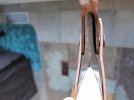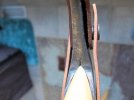It is not a bad weld - these are forged from a solid piece of steel - the eye is punched and drifted, the strongest way you can do it.
Drop forged axes usually have a punched and drifted eye, but this is done after the main forging and is done with a hydraulic press - two rams hold the axe while a third runs a punch/drift through it. This is a pretty precise setup as far as forging goes.
Gransfors on the other hand has an operator holding the work piece and a punch connected to the mechanical hammer comes down to make the hole. Then a drift is added and the hole is enlarged. after this process the blade is forged down to size - this is where you are getting this "defect". (I wouldn't consider it such) As they forge the blade down around the drift the metal stretches around the front of the drift and the result is this little spot you see. It's not a crack - it's an extension of the eye, so really there is no stress riser to worry about.
As for them being handmade - I would definitely put them into the handmade category. When you read articles about Collins Axes in the late 1800's they discuss very similar methods and while made in a factory where considered made "by hand".
I understand that you like what you like and if that spot is a deal breaker then it would be pretty easy to sell it and get a good smith to forge you one out paying close attention to avoiding pulling the eye out like that. Me personally, it is little things like that that make Gransfors such a pleasure to use and collect.
RMJ


